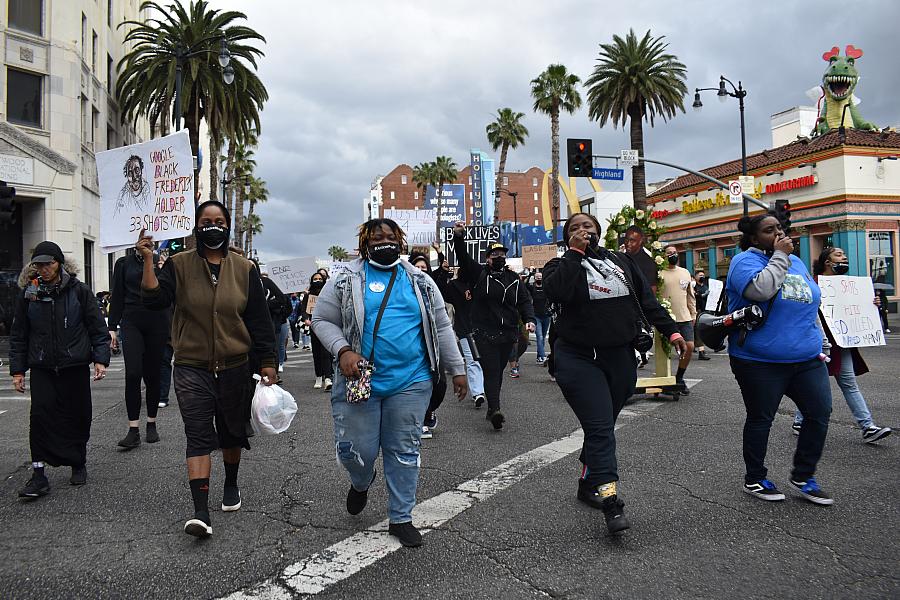New reporting project will map sheriff’s deputy violence and its impact in Los Angeles County

People gather in Hollywood to protest the shooting of Frederick Holder by deputies with the Los Angeles County Sheriff’s Department.
Photo by Cerise Castle
In the first two weeks of 2023, deputies with the Los Angeles County Sheriff’s Department shot and killed two people.
Both of them had not been charged with a crime. They had not been arrested. Like so many others who have died under similar circumstances, their lives were taken before they had a chance at due process, as was their right.
Neither of these deaths received significant news coverage. It is highly unlikely that any of the deputies responsible for these deaths will be charged criminally.
In any given year, Sheriff’s Department deputies shoot at least 10 Los Angeles County residents. Some of the victims survive. Many do not.
These shootings primarily occur in unincorporated regions of Los Angeles County, such as the Antelope Valley, East Los Angeles, Lennox, Santa Clarita and Willowbrook. Other spaces that contract with the Sheriff’s Department for law enforcement services, such as LA-area hospitals, transportation services, and smaller cities such as Compton, Lancaster Norwalk, and Palmdale, have also seen a substantial number of deputy shootings.
The majority of residents in regions with higher numbers of incidents are people of color. According to the CDC, many of these areas have some of the highest rates of social vulnerability — a measure that refers to a community’s ability to prepare for and respond to the stress of traumatic events — in the nation. Additionally, these neighborhoods are subjected to high rates of poverty and pollution.
Only a handful of deaths at the hands of deputies make waves in the news cycle. Coverage that does occur often focuses on the shooting itself. The victims are generally criminalized while their families are ignored and left to pick up the pieces in the aftermath of a disaster.
How does the trauma from injuries and killings at the hands of Sheriff Deputies impact the physical and mental health of survivors, victims’ families and the community around them? Which neighborhoods are subjected to the highest rates of deputy violence? This is what I am setting out to answer through my forthcoming project with the California Health Equity Impact Fund.
This data has not been quantified and presented in this manner before. To accomplish this, I will review public records on both fatal and nonfatal deputy shootings in LA County. That will allow me to identify the area with the highest levels of deputy-related violence.
Each incident of deputy violence will be mapped geographically and presented in an interactive, public-facing database. It’ll include pertinent details about each shooting, including the names of the deputies responsible, the victim’s name and demographics, and resulting injuries or death. Any deputy gang affiliation will be noted and cross-referenced with the deputy gang database I created. All public documents related to shootings will be available for users to download.
I’ll be speaking to residents of these neighborhoods about their experiences with LASD deputies, as well as families who have been impacted by a death or assault, about how the event affected them.
“It just messes with you. It messes with your mind. With your heart. With your body. We get nightmares. We get anxiety. It’s just so much. It takes a toll on you.”
Hilda Pedroza is the sister of David Ordaz Jr., a man who was in the midst of a mental health crisis when fatally shot by deputies. Ordaz was killed in front of his home, in front of his family. Eight of the 12 gunshot wounds entered through his back or side, meaning he was turning away from deputies as they fired. Remin Pineda, one of the four deputies who shot Ordaz, has been charged with one felony count each of assault with a semiautomatic firearm and assault under color of authority.
“It has completely changed my life,” Pedroza said. “I am a completely new person. I seriously get chills in my body. It's just so hard to explain. It’s like a lived nightmare.”
The insights of community organizations that work with individuals and communities that have experienced deputy violence are equally important. I will speak with several local health experts on the effects of living in the presence of a deadly police force.
Like recent research on the impact of “weathering” on Black Americans, I expect that the data I will uncover will highlight the very real consequences of living in a neighborhood where such deputy violence regularly occurs. I hope the data will be used by local agencies to adopt new policies and procedures to address and reverse any adverse effects on residents.

